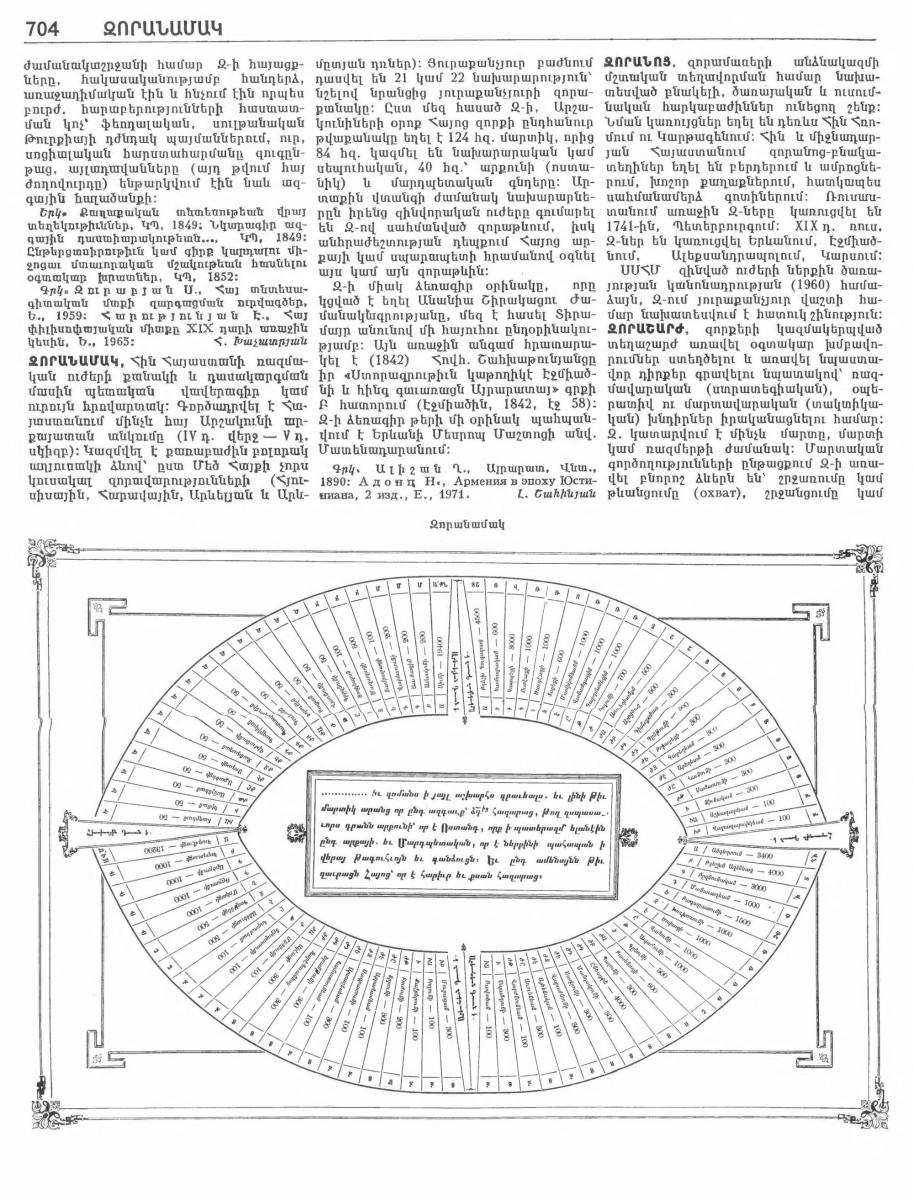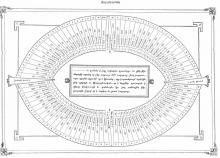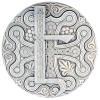The Military Register of the Kingdom of Greater Armenia during the Arsacid Dynasty (1st-5th centuries AD). The strength of individual Armenian noble houses based on their armies totaling 84 thousand men at arms + 40 thousand of the Royal Army together totaling 125,000 thousand.
This total number had tripled in the 1st century BC, during the reign of the King of Kings (Emperor) Tigranes the Great.

Zoranamak (literally: "military registrar") - Official state document regulating the number and division of military forces in ancient Armenia. Zoranamak was used in Armenia before the fall of the Arshakuni royal dynasty (end of the 4th - beginning of the 5th centuries). This official document was organized in a form of tetrahedral table in accordance with four military districts of Great Armenia: Northern, Southern, Eastern and Western gates. The military districts consisted of 21 or 22 naharardoms (principalities), each with the number of military forces indicated. According to the preserved Zoranamak, during the reign of the Arshakuni dynasty the total number of the Armenian troops was 124 thousand soldiers, out of which 84 thousand were Naharar (Sepuh) troops and the 40 thousand belonged to the royal regiments (vostanik) and internal guards (mardpetakan). In case of external threat, Naharars called up their troops and disposed them according to the military division determined in the Zoranamak. When necessary, they assisted other military divisions of the Armenian army under the command of the king or sparapet (commander-in-chief of the Armenian army).
The only copy of Zoranamak that was attached to Anania Shirakatsi's "Chronicle" retained until present days according to the information provided by an Armenian woman named Tiramayr. It was published in 1842 by Hovanes Shahatuniants in the second volume of "Description of the Cathedral of Echmiadzin and the ancient Ayrarat districts" ("Storagrutiwn kathoghike Echmiatzni yew hin gawarracn Ayraratay") (Echmiadzin, 1842 , p. 58). Today the manuscript of Zoranamak is stored in the Mesrop Mashtots Matenadaran in Yerevan.
Author: L. Shahinian
Source: The Armenian Encyclopedia. Volume 3. Published by the ASE, Yerevan, 1977-1979, pp. 704.
"…And there shall be many warriors whom thou shall place in 84 thousand to serve and safeguard the royal gates that are thy patrimony. And may they go on war for the king. And may there be the [service of] Mardpetakan within [the country] that should protect the queen and the treasury. And the general number of the Armenian army shall be one hundred and twenty thousand."
The Armenian princely families and their troops according to Shirakatsi's Zoranamak:
Eastern Gates
Southern Gates
1. Bdeshx* Gugarats - 4,5000
2. Kamsarakan - 600
3. Kaspetsi - 3,000
4. Uteatsi - 1,000
5. Tzawdeatsi - 1,000
6. Tayetsi - 600
7. Mamikonean - 1,000
8. Vanandatsi - 1,000
9. Gardmanetsi - 1,000
10. Vorduni - 700
11. Arweleanq (Arawelean) - 500
12. Ashotsean - 500
13. Dimaqsean - 300
14. Gntuni - 300
15. Boxaetsi - 300
16. Gabelean (Gabeghean) - 300
17. Abelean (Abeghean) - 300
18. Hawnuni - 300
19. Saharuni - 300
20. Dziwnakan (Dzyunakan) - 300
21. Ashxadarian - 100
22. Varazartikean - 100
Southern Gates
Western Gates
1. Angegh tun - 3,400
2. Bdeshx Aghdzneats - 4,000
3. Bznunakan (Bznuni) - 3,000
4. Manavazean - 1,000
5. Bagratuni - 1,500
6. Xorxoruni - 1,000
7. Tzophatsi - 1,000
8. Vahuni - 1,000
9. Apahuni - 1,000
10. Gnuni - 500
11. Basenatsi - 600
12. Paluni - 300
13. Yntzaki - 4000
14. Mandakuni - 300
15. Slkuni - 300
16. Varajnuni - 300
17. Aytzenakan - 100
18. Arwenean - 300
19. Varjnunean - 100
20. Spanduni - 300
21. Ropsean - 100
Western Gates
Northern Gates
1. Kadmeatsi - 13,200
2. Korduatsi - 1,000
3. Artzruni - 1,000
4. Rshtuni - 1,000
5. Mokatsi - 1,000
6. Golthnetsi - 500
7. Andzevatsi - 500
8. Harujean - 100
9. Trpatuni - 100
10. Mehnuni - 100
11. Akeatsi - 300
12. Zarehavanean - 300
13. Yeranthuni - 300
14. ?Hamastunean - 100
15. Artashesean - 300
16. ?Sagratuni - 100
17. ?Abrahamean - 100
18. Truni - 300
19. Bujuni - 200
20. Qajberuni - 100
21. Boguni - 100
22. Muratsan - 300
Northern Gates
Eastern Gates
1. Syuni (Siwni) - 19,400
2. Amaskoni (Amaskuni?) - 200
3. Awatzatsi - 200
4. Vardzaruni - 200
5. Tambaratsi - 100
6. Mazazatsi - 500
7. Tsolkepan - 100
8. Grzchuni - 50
9. Varnuni - 50
10. Bakan - 50
11. Kchruni (Krchuni?) - 50
12. Gukann - 50
13. Patsparuni - 50
14. Gzrikean - 50
15. Vijanuni - 50
16. Zangalan - 50
17. Sodatsi - 50
18. Akatsatsi - 50
19. ?Aschshnean - 50
20. ?Kichan - 50
21. Taygrean - 50
Notes on pronunciation:
· Letter 'x' in the names of Armenian naharars must be pronounced as 'kh', similar to 'ch' in German 'ich' or in Celtic 'loch'.
· Letters 'gh' in the names of Armenian naharars must be pronounced as French 'r'. This letter historically was the hard Armenian 'l' which gradually changed its pronunciation. Sometimes the same family name could be spelled with 'l' or with 'gh': e.g. Malxazuni - Maghxazuni. Both spellings are congruent.
© Union of Armenian Noblemen 2004
The only copy of Zoranamak that was attached to Anania Shirakatsi's "Chronicle" retained until present days according to the information provided by an Armenian woman named Tiramayr. It was published in 1842 by Hovanes Shahatuniants in the second volume of "Description of the Cathedral of Echmiadzin and the ancient Ayrarat districts" ("Storagrutiwn kathoghike Echmiatzni yew hin gawarracn Ayraratay") (Echmiadzin, 1842 , p. 58). Today the manuscript of Zoranamak is stored in the Mesrop Mashtots Matenadaran in Yerevan.
Author: L. Shahinian
Source: The Armenian Encyclopedia. Volume 3. Published by the ASE, Yerevan, 1977-1979, pp. 704.
"…And there shall be many warriors whom thou shall place in 84 thousand to serve and safeguard the royal gates that are thy patrimony. And may they go on war for the king. And may there be the [service of] Mardpetakan within [the country] that should protect the queen and the treasury. And the general number of the Armenian army shall be one hundred and twenty thousand."
The Armenian princely families and their troops according to Shirakatsi's Zoranamak:
Eastern Gates
Southern Gates
1. Bdeshx* Gugarats - 4,5000
2. Kamsarakan - 600
3. Kaspetsi - 3,000
4. Uteatsi - 1,000
5. Tzawdeatsi - 1,000
6. Tayetsi - 600
7. Mamikonean - 1,000
8. Vanandatsi - 1,000
9. Gardmanetsi - 1,000
10. Vorduni - 700
11. Arweleanq (Arawelean) - 500
12. Ashotsean - 500
13. Dimaqsean - 300
14. Gntuni - 300
15. Boxaetsi - 300
16. Gabelean (Gabeghean) - 300
17. Abelean (Abeghean) - 300
18. Hawnuni - 300
19. Saharuni - 300
20. Dziwnakan (Dzyunakan) - 300
21. Ashxadarian - 100
22. Varazartikean - 100
Southern Gates
Western Gates
1. Angegh tun - 3,400
2. Bdeshx Aghdzneats - 4,000
3. Bznunakan (Bznuni) - 3,000
4. Manavazean - 1,000
5. Bagratuni - 1,500
6. Xorxoruni - 1,000
7. Tzophatsi - 1,000
8. Vahuni - 1,000
9. Apahuni - 1,000
10. Gnuni - 500
11. Basenatsi - 600
12. Paluni - 300
13. Yntzaki - 4000
14. Mandakuni - 300
15. Slkuni - 300
16. Varajnuni - 300
17. Aytzenakan - 100
18. Arwenean - 300
19. Varjnunean - 100
20. Spanduni - 300
21. Ropsean - 100
Western Gates
Northern Gates
1. Kadmeatsi - 13,200
2. Korduatsi - 1,000
3. Artzruni - 1,000
4. Rshtuni - 1,000
5. Mokatsi - 1,000
6. Golthnetsi - 500
7. Andzevatsi - 500
8. Harujean - 100
9. Trpatuni - 100
10. Mehnuni - 100
11. Akeatsi - 300
12. Zarehavanean - 300
13. Yeranthuni - 300
14. ?Hamastunean - 100
15. Artashesean - 300
16. ?Sagratuni - 100
17. ?Abrahamean - 100
18. Truni - 300
19. Bujuni - 200
20. Qajberuni - 100
21. Boguni - 100
22. Muratsan - 300
Northern Gates
Eastern Gates
1. Syuni (Siwni) - 19,400
2. Amaskoni (Amaskuni?) - 200
3. Awatzatsi - 200
4. Vardzaruni - 200
5. Tambaratsi - 100
6. Mazazatsi - 500
7. Tsolkepan - 100
8. Grzchuni - 50
9. Varnuni - 50
10. Bakan - 50
11. Kchruni (Krchuni?) - 50
12. Gukann - 50
13. Patsparuni - 50
14. Gzrikean - 50
15. Vijanuni - 50
16. Zangalan - 50
17. Sodatsi - 50
18. Akatsatsi - 50
19. ?Aschshnean - 50
20. ?Kichan - 50
21. Taygrean - 50
Notes on pronunciation:
· Letter 'x' in the names of Armenian naharars must be pronounced as 'kh', similar to 'ch' in German 'ich' or in Celtic 'loch'.
· Letters 'gh' in the names of Armenian naharars must be pronounced as French 'r'. This letter historically was the hard Armenian 'l' which gradually changed its pronunciation. Sometimes the same family name could be spelled with 'l' or with 'gh': e.g. Malxazuni - Maghxazuni. Both spellings are congruent.
© Union of Armenian Noblemen 2004

